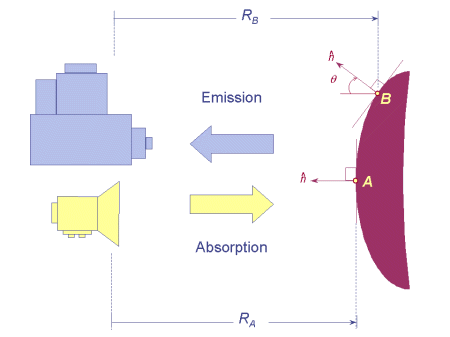| Complex Shape Surface Inspection by Infrared Thermography |
| Ph.D. |
| Clemente Ibarra-Castanedo |
| Xavier Maldague (Supervisor) |
 |
| Problem: Thermography for Nondestructive Testing (TNDT) is a non-invasive and fast inspection technique with the capability to perform remote inspections on large surfaces. These features give thermography an interesting advantage with respect to other NDT approaches. However, TNDT faces several problems that can be classified in three categories: (1) emissivity problems; (2) non-even heat distribution; and (3) surface shape. This study deals with the quantitative inspection of objects with complex geometry. |
| Motivation: TNDT techniques are usually used under the assumption that the part being inspected has a planar surface. However, when complex shape objects are examined, the surface shape produces a signal distortion that may lead to faulty defect detection. Heat emission (as well as heat absorption) is at its maximum when the normal to the surface is parallel to the direction of the flow of energy (see figure above). Therefore, the emitted (or absorbed) signal is weaker when there is an angle between the normal on the surface and the direction of flow. This intensity reduction is caused exclusively by the surface geometrical variations but it can lead to incorrect subsurface defect detection if corrective measures are not adopted. Moreover, the points furthest away from the source (or sensor) will absorb (or will emit) less energy compared to the closer ones. In reference to the figure shown above, in addition to the angle between the normal at the point B and the direction of flow, B is located further from the source (and from the sensor) in comparison to point A. Without shape information on the object, defects located under the surface just below point B will be difficult to detect by TNDT. |
| Approach: Shape-from-Heating (SfH), stands out among other shape correction TNDT techniques because, besides the traditional TNDT material, no additional equipment is needed. Furthermore, calibration steps are not mandatory. Shape extraction by (SfH) is made from the Early Recorded Thermogram (ERT), i.e. the first thermal image of the sequence in which defect contrasts have not yet developed, intensity variations are therefore exclusively related to surface geometry and not to the presence of a flaw. |
| Challenges: SfH performance is reduced due to non-even heating problems and frequency noise. Moreover, no quantitative shape correction model has been proposed yet that allows defect characterization (size and depth), in the presence of complex shape surfaces. Therefore, quantitative approaches like Pulsed Phase Thermography (TPP) combined with Neural Networks (NN); Wavelet Transform (WT); or Contrast Methods (maximum-Cmax, Differentiated Absolute Contrast-DAC) should be used once the shape correction is made. The challenge is thus to recover the inspected surface geometry and to correct the thermal images so that the detection and the characterization of defects are completed in a suitable way. |
| Applications: Aircraft industry is a good example of an application. Aircraft fuselage and wings are never completely flat. The inspection of aeronautical structures is carried out visually 90% of the time. The remaining 10 % of the time eddy currents are mostly used. Occasionally ultrasounds or other techniques are employed. However, these techniques are slow and they are prone to subjective interpretation and human errors. TNDT allows the examination of surface portions up to 4 m2, thus greatly reducing the inspection time making the technique especially interesting for the examination of aeronautical parts. Boiler tube corrosion characterization is another example of an application. |
| |
| Calendar:
Beginning: Autumn 2001
End: Autumn 2005 |
| |
| |
| Last modification: 2007/10/01 by ibarrac |

